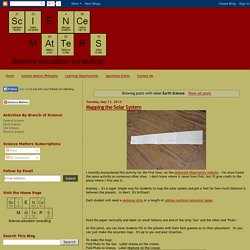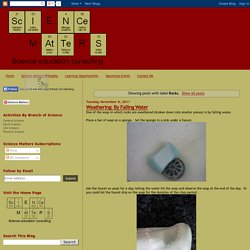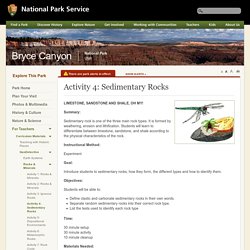

Joberts11 - Larissa's Igneous Rocks. Earth Science. This is a good one to do outside, if you can swing it.

If not, it can be done inside, you'll just need to work harder to contain the water. Materials: --Paper cup --Drinking straw --Clay -- Cookie sheet --Loose soil or sand --Jug filled with water (or other water source) Prep Work: Poke a hole in the side of the paper cup, near the bottom. Cut the straw in half and place one half in the hole. Seal the hole, around the straw, with the clay. For the Demonstration: Lay the cookie sheet upside down on the ground and raise one end about 2 inches, using scrap wood, a brick, a pile of soil, whatever's convenient. StudyJams. Beakers and Bumblebees. Today we discussed the five types of energy that we will be learning about this year.

We discussed light, heat, solar, sound, and electric energy! We learned that energy can be transferred and transformed. Those words sound so much alike, so we discussed the difference and came up with examples of each! Transfer: For this word we discussed transferring to a new school. When you transfer to a new school, you just move from one school to another. Transform: For this word we discussed transformers. Our new song! It was super day in Science! Beakers and Bumblebees. Rocks the Charlotte Mason Way. Living books plus hands-on investigation are hallmarks of a Charlotte Mason (CM) education.

Our study of rocks & minerals was right along those lines. I wanted to start off with something that would immediately get Sprite enthusiastic about the topic, so I assigned her to choose any four rocks from our collection and fill out the Rock Detective page from Considering God’s Creation. CGC is a wonderful resource for elementary level science and nature study. You can read my review of this curriculum here. Downloads/science/rock-cycle-papercraft-activity.pdf.
Rocks. It's very simple to start a sand collection - every time you visit a beach or other sandy location, collect a small sample in a zip-top bag.

Ask your students to do the same on their travels, as well as colleagues and family members. It won't take long and you'll have a variety of sand samples to compare and contrast. You can keep your samples in clear plastic bags and use a magnifying glass to observe, or if you've got the resources, you could store the samples in magnifier boxes. The diversity of the samples will provide a variety of discussion points. What is the sand made of? For instance, the above sample was photographed (because one should never remove anything from a national park) at Acadia National Park. I'm particularly fond of the blues, purples and greens.
Along the same lines, retired science teacher Charles Lindgren has created the Science of Sand website. His samples are organized by state and country, and you're welcome to use the images for a virtual sand lab. What Is a Sedimentary Rock? Pyramid Diorama (Triarama) Templates & Directions. Rocks and Minerals Choice Board.pdf. Pin by Roots And on science. The Rock Buffet: New Unit! So…ummm…you remember my Rock Buffet post?!?

From a YEAR ago?!? Well, I actually finished up piecing that very unit together, and believe it or not, it is up on TPT! Y'all have been asking for this for the past year, and I so appreciate your patience. I tried to make it worth the wait. There might…just might…be a unit song that I've shared below. Check out how I teach rocks and minerals below... We began this unit by discussing how rocks are created. During our observation, the students recorded how the rock was formed. Once we had this basic concept mastered, along with the three observable properties of minerals, we moved on to the three types of rocks. My BFF {YouTube} found me this fabulous video which demonstrates how to create the three types of rocks with food. Yes...his apron says kiss the geologist! The students recorded observations, and created definitions to describe the process that each rock goes through.
Sedimentary Rock. Igneous Rock. Volcanic Rock Fragments. Rocks. Rocks & Minerals - Bryce Canyon National Park. Activity 4: Sedimentary Rocks - Bryce Canyon National Park. Chemical Sedimentary RocksWater traveling through rock dissolves minerals and transports them away.

Chemical sedimentary rocks form from these minerals. Eventually dissolved minerals are redeposited, or reprecipitate, when the water evaporates or when the solution becomes over-saturated with minerals or when the water enters an area of low pressure, like a cavity in the rock. Some chemically precipitated rocks include stalactites and stalagmites you see in caves (also known as travertine). Chert is a precipitated rock from silica-saturated waters. Rock salt, known as table salt, is the result of water evaporating from salt-rich water. How do Sediments Become Sedimentary Rocks? Cementation is the word given to the sticking together of sediments by additional material between grains. Sedimentary Rocks are Clues to Past Environments Sedimentary rocks can tell a geologist much about past environments. Why do Geologists Need to Identify Sedimentary Rock?
Instructional Procedures: